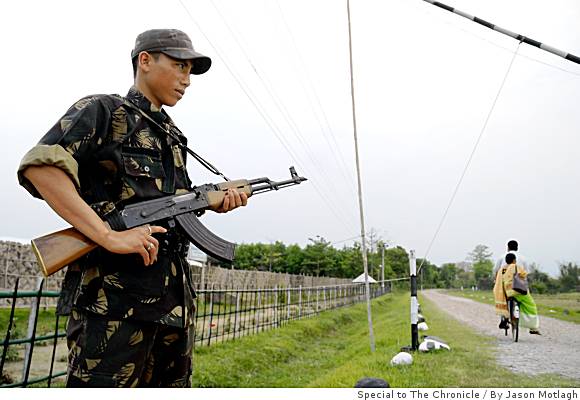
Udalguri, India -- Flanked by mist-bearded foothills, groups of young men play volleyball on a grass clearing, jog around plywood barracks and chop wood. If not for the presence of automatic weapons, the scene could pass for a summer camp .
Until three years ago, an estimated 2,000 rebels of the National Democratic Front of Boroland relied on hit-and-run tactics and a base across the border in neighboring Bhutan to carve out an independent homeland in the northeastern state of Assam. But since entering a cease-fire agreement with the Indian government in 2005, these ethnic Boros - also known as Bodos - have been relegated to three camps to await an end to decades of conflict.
"Before the cease-fire, this area had no peace at all," said Prafulla Basumatari, a high school principal whose adobe home sits nfear the rebel barracks on the outskirts of the town of Udalguri. "All the time there was a fear in the minds of people; when and what would happen, nobody knew."
A tense climate
Even though full-scale gunbattles no longer send locals scrambling for cover, a tense climate remains in this rugged terrain of steep jungle valleys, mighty rivers and 1.3 billion tons of proven oil reserves. The economic potential and the struggle for diminishing arable land between roughly 350 ethnic groups and a steady influx of migrant workers from Bangladesh have sparked a dozen low intensity insurgencies since the 1970s at a cost of some 20,000 lives.
Most analysts say the long-standing conflict is also fueled by a lack of Indian troops and the ability of the rebels to finance the conflict through drug trafficking and extortion of tea and timber companies. But these same analysts also agree that rugged topography, ethnic rivalry and the military superiority of Indian forces will blunt any long-term threat of separatism.
"The very nature of movements rooted in ethnic identity has made it impossible for them to go beyond their demographics, so these movements are circumscribed, and inevitably, will destroy themselves," said Ajai Sahni, director of the Institute for Conflict Management. "These movements know they cannot really stand against the Indian state."
Meanwhile, the Indian government is set on transforming the region into an economic gateway to Southeast Asia. Companies from neighboring countries have been invited to invest in the exploration of oil and natural gas with the hopes of creating thousands of jobs.
"Make no mistake, the majority of people in the northeast today are not anti-Indian," said Sahni. "People have accepted India as their country."
'Reduced to a minority'
Brahman Baglary, peace and rights officer for the National Democratic Front, disagrees.
"As you know, indigenous people are not to be separated from our land rights," he said. "These were snatched by the Indian government."
Like many ethnic Boros, Baglary says the central government allows tens of thousands of Bangladesh immigrants to flood ancestral lands and Indian and foreign companies to plunder the region's natural resources. He shares a popular sentiment that it's all part of a plan to dilute their cultural identity.
In a 1996 report, then-Assam Gov. S.K. Sinha agreed.
"As a result of population movement from Bangladesh, the specter looms large of the indigenous people of Assam being reduced to a minority in their home state," he wrote. "Their cultural survival will be in jeopardy, their political control will be weakened and their employment opportunities will be undermined."
In the meantime, talks for a final peace settlement remain on hold.
Conflict fatigue
A senior Indian intelligence official, who requested anonymity due to the sensitivity of his post, blamed Baglary's rebel group for not submitting an official list of demands. In response, rebel leaders say they have not only submitted demands but have been waiting for the past three years for an Indian envoy to move the peace process forward.
"If this is the attitude of the Indian government," said rebel Lt. Pwilao Mushahary as he placed his right hand on the 9mm pistol tucked in his belt, "the (National Democratic Front of Boroland) is ever-ready to go back to the jungle and renew our struggle afresh."
N.G. Mahanta, a security expert at the University of Guwahati in the capital city of Assam, says conflict fatigue is a time-tested strategy of the Indian government.
"If you fight the Indian state for 10, 15, 20 years, after that you don't believe you can beat the Indian state," said Mahanta.
Assam's troubled history
Between 1838 and 1947, Assam remained part of the British empire. At the time of the partition of India and Pakistan, the region's most prominent ethnic groups expected independence, thus justifying the insurgent wars that followed.
Today, Assam's 27 million people and some 350 ethnic groups live in a 30,285 square-mile area, nearly the size of Ireland. Assam is famous for tea (its black tea accounts for 55 percent of India's production), oil, natural gas, and 23 national parks and wildlife sanctuaries. It is one of the last wild habitats for the Asian elephant.
Since the 1970s, a war between the Indian military and local rebel groups has claimed 20,000 lives. In recent years, violent deaths in the northeast have steadily declined, from 1,317 in 2001 to 635 in 2006, according to the Institute for Conflict Management, a security think tank in New Delhi. In 2007, 450 people were killed in Assam - mostly civilians - according to a senior Indian intelligence official, who requested anonymity due to the sensitivity of his post.
The most prominent rebel groups are:
-- The National Democratic Front of Boroland. Formed in 1988, the NDFB has an estimated 700 fighters, who live in three designated camps while waiting for a final peace agreement.
-- United Liberation Front of Asom. Formed in 1971, ULFA's estimated 400 fighters still attack the Indian military and civilians.



